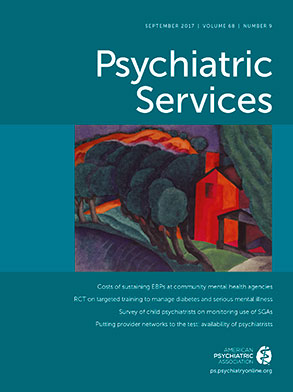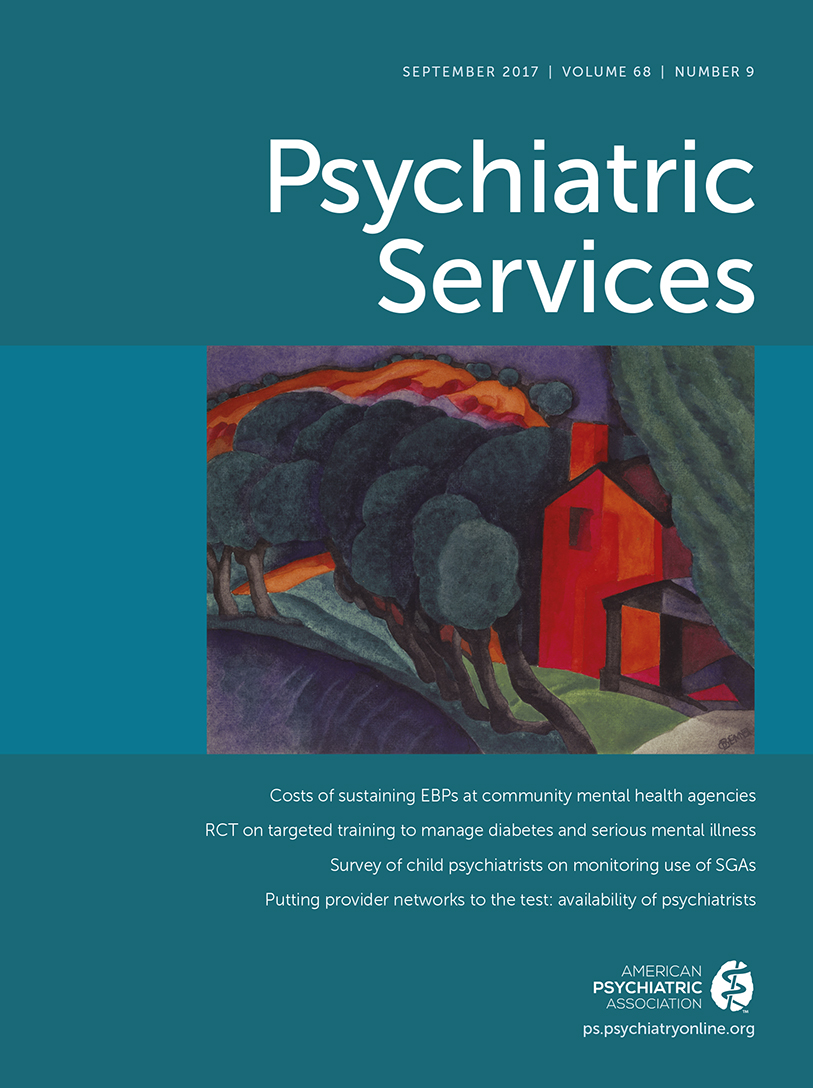Since deinstitutionalization of patients with psychiatric disabilities began in the 1960s, many mental health services have shifted from hospitals to community-based care. The general idea was that community-based services would allow patients with serious mental illness to live independently in the community and avoid costly and potentially traumatic hospitalizations.
Assertive community treatment (ACT) is a well-established, evidence-based model of community care for individuals with serious mental illness and has been shown to reduce rates of hospitalization, improve housing stability, and reduce substance use (
1,
2). In our province of Ontario, Canada, ACT teams have existed since 1998, with 79 teams currently operating across the province (
3). The ACT model, however, is not without limitations and challenges. A key feature of ACT is “time-unlimited” services, which have been interpreted to mean “forever services” by some care providers, leading many teams to quickly reach capacity and develop long waiting lists (
4). There also may be limited local resources for transitioning psychiatrically stable patients to less intensive services when they no longer require ACT-level care. Lack of access to ACT may be exacerbated in Ontario in that some teams chronically operate below their full-capacity caseload for unclear reasons (
3), although staff workload, staff retention, and referral and admission processes may be contributing factors. A recent review of Ontario’s ACT services noted a high turnover rate for psychiatrists. The review also found that, despite local support for supplemental ACT resources, such as peer support, vocational support, and integrated substance use treatment, these services were not consistently implemented (
3). The current average waiting time for ACT-level services through a centralized access point in Toronto is approximately one year (
5).
Since the introduction of ACT, there has been steady development of other models of community-based services, including intensive case management (ICM). The ICM model of care is not as well defined as ACT. Compared with ACT, ICM teams provide individual rather than team-based case management and have higher caseloads (approximately 20 patients per case manager in ICM compared with ten patients per case manager in ACT), less access to psychiatrists and team supervision, and less intensive outreach capability (
2). Despite ample evidence for successfully transitioning selected patients from ACT to less intensive services (
6), including ICM, facilitating continuity of care for patients with serious mental illness and varying service needs remains challenging, even when care is appropriately stepped up or down between ACT and ICM teams.
Some individuals with serious mental illness may not be well served by either ACT or ICM models. ACT teams have historically given preference to patients with psychotic illnesses and bipolar disorder (
7). Other patients with complex health and social needs may be turned away from ACT teams, including those with primary substance use disorders, developmental disabilities, and personality disorders. Current limited research on this topic suggests that ACT may not be the most appropriate service for some of these patients (
8), but high-intensity alternatives do not exist. Although ICM services are less restrictive and potentially more available than ACT services, ICM’s lower intensity of care may not be sufficient. This is particularly relevant for patients with challenging life situations such as serious general medical comorbidities, unstable housing, or criminal justice involvement.
The need to provide accessible, affordable, and evidence-based care to this underserved patient population in Toronto led us to examine alternatives to both ACT and ICM that allowed for flexibility in providing different types and intensity of service based on evolving rehabilitation and recovery needs. This search led us to a modified version of ACT known as flexible ACT (FACT).
Building Flexibility: FACT
In the past 15 years, the Netherlands has innovatively revised the classic ACT model, developing FACT (
9), a multidisciplinary team of 11–12 full-time clinicians who provide services to 200–220 patients with serious mental illness in a catchment area of 40,000 to 50,000 inhabitants. The team consists of the full-time equivalent (FTE) of one psychiatrist, five to eight psychiatric nurses, a psychologist, an employment specialist, a peer support worker, a social worker, and two addiction specialists. The team can switch back and forth between ACT and ICM levels of service intensity on the basis of patients’ changing needs. At any given time, approximately 20% of patients receive ACT-level services from the entire team while the remaining 80% are provided with ICM-level care by one primary case manager, with team support as needed for specific tasks such as employment searches, addictions treatment, and medication monitoring. FACT is designed to provide “services to 100% of people” with serious mental illness (
10). In the Netherlands, serious mental illness is defined as having a psychiatric disorder that requires treatment as well as having severe limitations in social and community functioning. These two criteria must be systemic, long term, and related to each other. The person must also show need of coordinated care to implement a treatment plan (
10).
The model is extensively implemented in the Netherlands, with about 300 operational teams, and was recently adopted in the United Kingdom (
11). However, the adoption of FACT remains controversial. In North America, a notable response to FACT cited its lack of rigorous evaluation as a major concern (
1), and a recent Swedish review of the existing, limited outcome data highlighted that FACT lacks evidence of effectiveness (
12).
In response, the Dutch FACT organization argued that a lack of rigorous outcome evaluations is not equivalent to a lack of effect and cited alternative interpretations of existing studies that found higher treatment response rates for FACT compared with usual care (
13) and improvements in quality of life, treatment adherence, hospitalization rates, service utilization rates, and getting their needs met (
14). Although these findings are promising, evidence of effectiveness of this innovative model has yet to be established.
In the absence of evidence via controlled studies, it is important to highlight the nature of FACT’s three key innovations. First, FACT, recognizing the changing service needs of patients over time, combines both ACT and ICM on the same team, maintaining continuity of care and patient-clinician relationships. Second, it serves in an affordable manner two to three times more patients with broader, more inclusive admission criteria than ACT uses, with a similar complement of staff. Third, FACT has made recovery-focused work more explicit and central to community care through a focus on peer support, vocational assistance, and partnering with patients in the development of goals and treatment plans (
10).
Improving Access and Value in Toronto
In Toronto, which has offered ACT services for 20 years, it was befitting to consider elements of the FACT model to improve access, enhance value, and prioritize evidence-based care for a broad range of patients with serious mental illness and complex needs. To achieve this, in April 2014 we transformed a traditional, high-fidelity ACT team into a program that borrowed from FACT guidelines and adapted them to fit our local needs. To the best of our knowledge, this is the first adaptation of the FACT model in North America.
Like the original FACT, our redesigned integrated services team is multidisciplinary, with 15 case managers with a variety of community and health care backgrounds and experiences. Specialized staff was added to complement the ACT case managers. We aim to have a staff mix of five psychiatric nurses, two occupational therapists, two social workers, two peer support workers, a personal support worker, two addiction specialists, and one vocational specialist. Additional resources include a team leader with direct patient interaction and a full-time clinical psychologist who provides individualized and group therapy using cognitive-behavioral and dialectical behavior therapies. In addition, the team works closely with psychiatrists (total 1.3 FTE). In many ways this transformation has been seamless because FACT is modeled on ACT principles and shares many of its operational features. In addition, we consulted with the Dutch FACT organization and their FACT manual for our transformation. Also, over the past three years we have modified our initial model as part of multiple quality improvement initiatives. [An appendix available as an online supplement to this column compares the current organization of our team with traditional ACT and FACT teams.]
Our team is located in an inner-city area of Toronto, with approximately 130,000 inhabitants in its catchment area. Many homeless shelters and community support agencies are located in this area, and 27% of households live below the poverty line. The local unemployment rate is the highest in the city (
15). Team eligibility criteria target traditional ACT patients as well as a broad range of patients who are experiencing serious mental health problems that impair their functioning within their community. [Admission criteria are described in the
online supplement.]
Our local adaptation uses the key FACT feature of flexibility, transitioning patients between intensive ACT services and less intensive ICM services within the team, depending on their level of need. At any given time, 40%−60% of our patients may require ACT-level care. The 20%−80% breakdown between ACT and ICM levels of care described in the Dutch model is based on limited field research, and it is commonly acknowledged to be a shifting number depending on context (
1). In addition, our team is designed to serve 190 patients; thus the staff-to-patient ratio is modestly higher than the FACT guidelines recommend (about 13 patients per case manager on our team compared with 20–22 patients per case manager on a FACT team) to reflect the higher level of needs in our urban, socioeconomically marginalized population. We use FACT’s approach to daily meetings, discussing only 20–30 patients who currently require daily care and attention. Use of the FACT guidelines has been helpful in strengthening our focus on recovery-oriented work.
Limitations
Community mental health services vary across different jurisdictions, which may affect the generalizability of this work. In the Netherlands, FACT teams adhere to strict fidelity and certification processes, which are yet to be developed in North America. The design of our team nonetheless was informed by the existing literature on FACT and by our particular local needs.
Implications and Future Directions
Our adoption of the FACT model is based on clinical experience, economic reality, local mandates, and preliminary positive findings from Europe. We believe that this effort represents an important step toward continued innovation of community care for people in North America with serious mental illness. This work will allow us to identify potential benefits and challenges of such an endeavor, providing a blueprint for other ACT teams that may want to innovate to address current challenges in service delivery.
To evaluate this first adaptation of FACT in North America, an initial pre-and-post study is underway of approximately 100 new patients who had not previously received ACT care. Measures include patient wellness, substance use, forensic involvement, rates of hospitalization, and emergency department utilization. Qualitative interviews with staff and service users will provide input into the acceptability and experiences of the model, and we plan on later completing an economic analysis. Through this work, we hope to contribute to the ongoing evaluation of a potentially impactful new model of care.
Acknowledgments
Transformation of the local assertive community treatment team and ongoing evaluation of the program are funded by the Toronto Central Local Health Integration Network. The program is a partnership between St. Michael’s Hospital and Cota, a community mental health organization, in Toronto.

